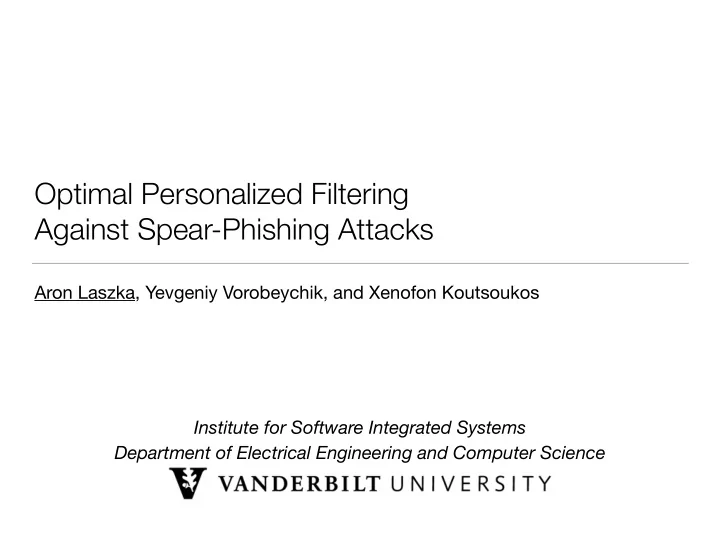

Optimal Personalized Filtering Against Spear-Phishing Attacks Aron Laszka, Yevgeniy Vorobeychik, and Xenofon Koutsoukos Institute for Software Integrated Systems Department of Electrical Engineering and Computer Science
Malicious E-Mails Spam Spear-phishing • non-targeted • targeted • usually just a nuisance • potentially very high losses (but can waste a lot of time (even from a single attack) and money in high volumes)
Spear-Phishing Examples • In 2014, a German steel mill suffered “massive” physical damage due to a cyber-attack first step of the attack was spear-phishing • http://www.wired.com/2015/01/german-steel-mill- hack-destruction/ • In 2013, millions of credit and debit card accounts were compromised due to an attack against Target first step of the attack was spear-phishing • http://www.huffingtonpost.com/2014/02/12/ target-hack_n_4775640.html
Filtering Malicious E-Mails deliver incoming maliciousness comparison classifier e-mail score with threshold • Threshold • too low → too many false positives (FP) discard • too high → too many false negatives (FN) • optimal value: minimizes FP rate × cost of FP + FN rate × cost FN
Multiple Users Cost of FN (potential loss from delivering malicious e-mail) Cost of FP (potential loss from discarding non-malicious e-mail)
Personalized Thresholds Threshold optimal uniform threshold optimal personal thresholds optimal personal thresholds targeting attacker may exploit should also take the attacker’s the differences not only between strategy into account the users but also between the personalized thresholds → game theory
Game-Theoretic Model Defender Targeting attacker • for each user u , selects • selects a set of users A , a false negative rate f u and sends them targeted malicious e-mails • we assume that the • can select at most A users feasible FP / FN rate (otherwise the attack is pairs are given by a easily detected) function FP ( f u ) ( ) Non-targeting attacker(s) FP • non-strategic (not a player) f u
Game-Theoretic Model (contd.) Stackelberg (leader-follower) game 1. defender selects a false negative rate f u for each user u expected loss from 2. attacker selects a set of users A targeted attacks Attacker’s utility: expected loss from non-targeted attacks Defender’s loss: expected loss from Lu : potential loss from delivering targeted malicious e-mails from false positives Nu : potential loss from delivering non-targeted malicious e-mails Cu : potential loss from discarding non-malicious e-mails
Characterizing Optimal Strategies f u L u Λ A optimal value for a user given that it is not selected by the attacker optimal value for a user given that it is selected by the attacker
Finding an Optimal Strategy For a given value of Λ , we can find an • optimal strategy using the following Finally, we can find the • polynomial-time algorithm optimal value of Λ using a simple binary search Λ
Numerical Examples • Datasets • UCI Machine Learning Repository: 4601 labeled e-mails with 57 features • Enron dataset: 13,500 e-mails with 500 features • Classifier: naive Bayes (note that this is just for the sake of example) • False positive / false negative rates: UCI Enron
Numerical Examples - Results 31 users with parameter values following power-law distributions • UCI Enron Number of users targeted A optimal strategy uniform threshold not expecting strategic attacker uniform threshold expecting strategic attacker
Conclusion & Future Work • Conclusion filtering thresholds have received less attention in the past • we proposed a game-theoretic model for targeted and non- • targeted malicious e-mails we showed how to find optimal strategies efficiently • numerical results show considerable improvement • • Future work non-linear losses from compromising multiple users •
Thank you for your attention! Questions?
Recommend
More recommend